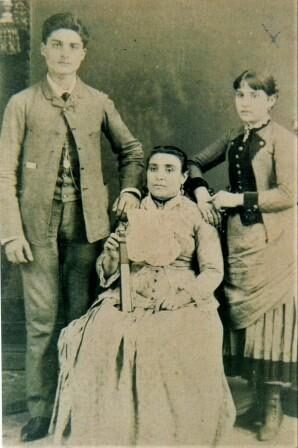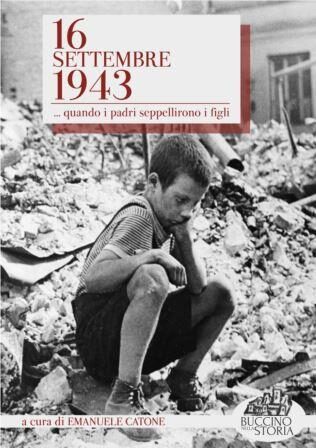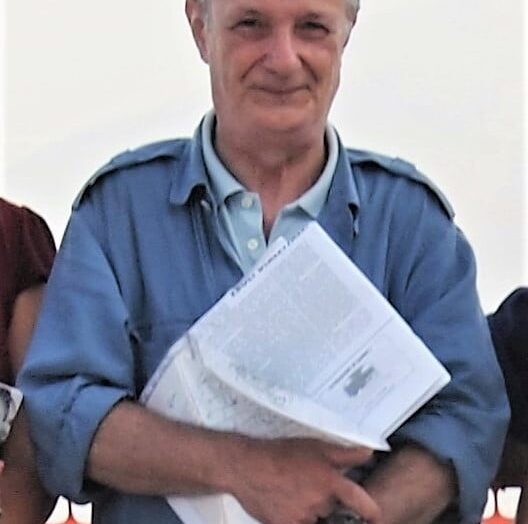Text by Estela Alicia Mancini
Adaptation and revision of Emanuele Catone
Thanks to the invitation of my friend Emanuele Catone, with great pleasure I advance to the readers of "Buccino nella Storia" a part of my research, thanks to which it is now possible for me to tell the story of my great-grandparents and their children. I will start from the life of my great-grandfather Antonio Pucciariello which I divided into two parts due to the length of the story.
My four great grandparents were Antonio Pucciariello and his wife Angela Di Benedetto – both buccinesi, Carmela's parents, my maternal grandmother – and Pasquale Morriello and his wife Maria Pucciariello, also from Buccini, Alfredo's parents, my maternal grandfather. My four great grandparents left Buccino in the 1884, almost simultaneously, and moved to Argentina.
Their life in Argentina was not easy, as for all the emigrants of that period. After a dangerous journey, you came to a country where another language was spoken and there were different ways of living, so through a lot of work we tried to make progress and create new families overseas. Despite the absolute gratitude for the country where you had the opportunity to lead a better life, the difficulty remained of starting one's own life again: uprooting always remained an open wound and was passed on from generation to generation. In Argentina, where people came from all over Europe, Italian immigration was the numerically largest one: about the 60% of the Argentine population has Italian origin and almost the 90% has at least one family member born in Italy. For this reason, the majority of Argentines understand the Italian language a little, for having listened to words many times, phrases and songs, but few have invited their children or grandchildren to learn the language of their homeland.
I am part of the third generation born in Argentina from Italian families or better – as a writer says – I am a descendant of Italians born abroad. Of my eight great grandparents, indeed, 6 they are italian (4 by Buccino, 2 always from Campania and 2 Spanish, originating from a village in Galicia). I learned the family story first from my grandmother and then from my mother. To avoid that memory is lost and that the new generations of my family forget their origins, I decided to write a book, which is now almost complete, in which I am necessarily trying to integrate the life stories of my family in the historical and social context in which they lived, both in Buccino and in Argentina. All of them have been, indeed, not only witnesses but also actors of history.
Pietro Pucciariello and Maria Carmela Landolfi. Antonio's father, my great grandfather, his name was Pietro Pucciariello and he was born in Buccino on 2 December 1838 at 16 and his birth was recorded by his father the day after the municipal registrar1. In fact at the time, in a small town like Buccino where there were no hospitals that were close enough, children were born in homes, but the parents had the obligation to declare their birth together with some witnesses. A new registration, this time in church, it was done at the time of baptism: Pietro was baptized in Buccino on 3 December 1838 in the church of S. Giovanni Gerosolimitano2.

Pietro's father was named Antonio, was born in Buccino on 6 marzo 18033 (at the birth of the son he had therefore 35 years) and his profession was that of laborer (the Pucciariello family owned, indeed, some land with olive trees). Pietro 's mother was called Maria Luisa Villano and was born in Buccino on 9 April 18064 (then, at the time of the birth of his son he had 32 years). Antonio and Maria got married in the church of S. John the 3 May 18285.
Little Pietro lived in the San Giovanni neighborhood, near Porta San Mauro, one of the ancient access gates of the town. Buccino, indeed, despite being a medium-sized country and with approx 5000 inhabitants, it consists of six neighborhoods that develop along the slopes of a hill. Being a country of very ancient origin, still retains three of the ancient doors that allowed entry to the country. During the Middle Ages, indeed, high walls and entrance / exit gates were built in cities to protect themselves from possible invaders, as in the case of Buccino, where even today the ruins of a Norman castle can still be seen.
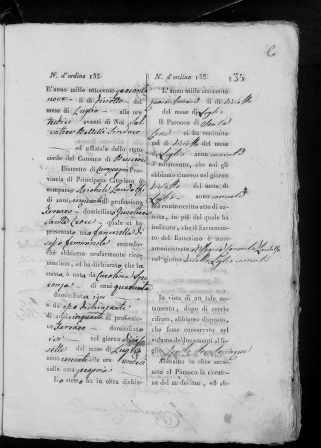
Pietro's future wife was called Maria Carmela Landolfi and was born in Buccino on Tuesday 17 July 18496. She was the daughter of Michele Landolfi, a blacksmith (ferraro) that at the time of the birth of the daughter she had 50 years, and Maria Carolina Rosa Speranza who had 45 years. Maria Carmela was the youngest of nine brothers, some of which (Giuseppe and Vincenzo) they would then do the same job as their father.
The years passed and at some point the parents of my great grandparents crossed their path and got married. The marriage between the two took place on Thursday 8 February 1866 when Peter had 28 years and Maria Carmela 16 and a half years7. Three children were born from their marriage: Giuseppe, who died a few months8, Antonio (Born on 2 novembre 18699, my grandmother Carmela's father, that, as was tradition, it had the name of the paternal grandfather) and Maria (Born on 22 April 187210, my grandfather Alfredo's mother). My maternal grandparents, parents of my mother Elida, they were therefore first cousins.
Antonio Pucciariello. Antonio, as well as his brothers, he was born in his home in via Piano, one of the main streets in the Santa Croce district, which is located at the foot of the Buccino hill and takes its name from the nearby church.
In relation to via Piano, where my great grandfather lived, I'm glad to tell you something that happened to me when in 2016 I was able to visit and get to know Buccino. Everything that happened to me while I was there, it was deeply moving. As soon as I put my feet there, I had the feeling that they had been waiting for me for a long time. A man, which bears the same name as my great grandfather, Antonio Pucciariello (probably a relative of my family, more or less far) he received me without having previously agreed and decided to accompany me for a walk to show me Buccino. He introduced me with joy to the people of the country we met.
Then, took me to the "Piano road", the street where my great-grandfather's house was located, and showed me where the exact location was. Home, who had remained standing despite the elapsed time and wars, she was gone because she hadn't been able to resist the force of nature in the terrible earthquake that hit Buccino on 23 novembre 1980 at 19.34. This earthquake destroyed the country of our ancestors, which has been rebuilt in a modern way, and it was not possible to recover all that was lost.
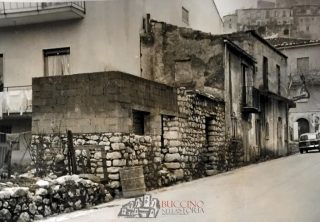
[Photo Buccino Archive in History]
So for a moment I stayed there, trying to imagine what my great-grandfather's house could have been like, with its large and stone walls, with a few small windows and an old wooden door. Unfortunately I had arrived with 26 years of delay… The image of the house I was thinking of vanished immediately as soon as I turned around and, changing the point of view, I saw something in front of me that left me perplexed: the beautiful panorama that Antonio saw every time he opened the door of his house during all the years he lived there. And what was it? A view of the mountains and an infinite sky. That incredible landscape that I was looking at was the same that my great grandfather had looked at many times.
Faced with this landscape, a memory of my mother came to mind about her conversation with Antonio. One evening, indeed, my mother, already married, went to see him at his house, with me, that I was a few months old baby, and my sister, who was then two years old. While my sister went to play, my mother, while I slept in his arms, he started talking to him, who was sitting by his window. That day for some reason Antonio decided to send her some life tips and to share the memories of his land with her. My great-grandfather Antonio would have died that same year, at the age of 95 years, when I was five months old, and perhaps he felt that he had little time left to live and chose my mother among the many children and grandchildren of his family. While his hand caressed my face, Antonio spoke to her about those rules that are essential in life. After, not being able to avoid nostalgia, spoke of his land: he began by saying of a blue sea and high mountains, but his eyes filled with tears, and he could no longer speak, but my mother understood everything. He had enormous gratitude for Argentina, but it was very painful for him to remember and during most of his life he preferred not to recall those memories, leaving them there, in the distance. But when we get older we think back on our life a lot, we return to the past more often, the need arises to teach all that has been learned and the melancholy of loved ones returns. That moment with Antonio, left a very deep impression on my mother, who has never forgotten it. Sometimes I could feel that time seems to stop when two people come together in such a special way and I think that way my mother lived that moment. And suddenly I was there, looking at his mountains with this thought.

Going to Buccino was a dream for me, and at the same time I felt a lot of anxiety because I didn't know how I would be received: I was returning to it 132 years after my great-grandparents were gone. I felt that they were there next to me and, with a lot of emotion, I said out loud: "here I am, I am arrived!». The people of Buccino gave me a very affectionate and kind welcome.
I must say that after listening to the stories of the country where the emigrants were born, the problem is often to create an image that matches the description. This is often impossible, because there is no comparison with being there and walking through those places. It is as if the roots of the earth from their depths pushed up to penetrate through the soles of our feet, recognizing us as the heirs of those who left, recognizing us as proper to that land.
Returning to Antonio's life, I have many questions that I will not be able to answer: how was his childhood? how many and what his friends were? how many uncles and cousins he met?
Antonio, like his sister Maria, did the schools in Buccino. I don't know why they decided to emigrate to Argentina, although I may speculate on some.
The era in which Antonio lived in Buccino was a complex period, following the unification of Italy. The unification, indeed, it involved a difficult and long organization of the various states, and it took many years to complete this process. A failed agricultural reform and high taxation condemned many Italians to poverty, especially in southern Italy, which until then had been ruled by a monarchical regime. At that time, Moreover, the industrial revolution had not yet arrived and a cholera epidemic devastated the country. I think these may have been some of the reasons people decided to emigrate.
In the case of Antonio's family, But, there was one more reason. In fact, Pietro Pucciariello died at just over forty years old on 1 October 188011, leaving his wife, that he had then 35 years, and the two sons Antonio and Maria, respectively of 15 e 12 years.
Maria Carmela was the youngest of eight brothers who had a great age difference with her. The death of her husband, which was added to that of his parents12, made the future of his children uncertain and, probably due to the fact that at least two of his brothers had already moved to Argentina, she also decided to leave.
The journey from Buccino to Naples did not have to be easy. I don't know how the approx 120 kilometres, perhaps on horseback or with a cart, and if it took several days. Maria Carmela and her sons embarked on Thursday 17 July 1884 – presumably at the port of Naples – on the ship called "Il Pampa", a French steamship of the Charguis Renuis company which left the port of Genoa.
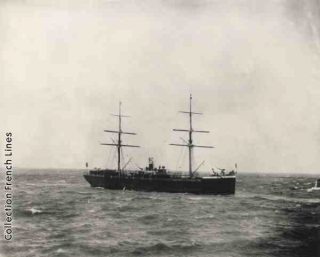
The journey took about a month, depending on the stopovers the ship made and the sea conditions. Argentina arrived on 17 August 1884, on a winter Sunday. It was difficult to locate them on the ship's passenger list because they were registered with the mother's surname, Landolfi, and not with that of Pucciariello, with which I was looking for them. It is likely that Vincenzo welcomed them upon their arrival in Argentina (Vicente) Landolfi, Maria Carmela's brother, four years older than her, who had arrived in Argentina in 1870/1871 and that at that moment he was married and already had five of his eight children. He lived in Buenos Aires in the Belgrano neighborhood where, according to the census of 189513, he was a blacksmith, thanks to which he had managed to secure a good condition.
According to what my grandmother told me, Antonio had already managed to open his own business after four years in Argentina. From Antonio's passport we know that his job was that of "tinman", therefore it is possible that this profession has already learned it in Buccino, and it is almost certain that at first he worked with his uncle Vicente, who had to help him fit in, as was the habit of being a friend and family member for a newly arrived emigrant.
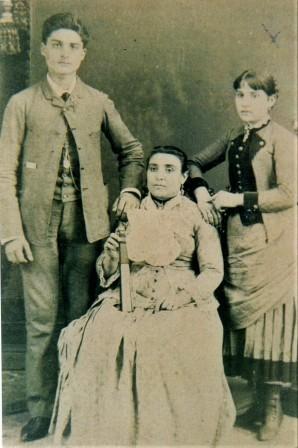
According to my grandmother's stories, to help Antonio in some way in the development of his artisan activity must also have been another Italian family, i Bellagamba, who greatly admired my great-grandfather Antonio because they considered him a great worker who in a few years had managed to make great progress. My grandmother Carmela, indeed, he had great affection for that family, who lived in the same neighborhood as Vicente. Even my mother had the chance to get to know the Bellagamba family when she accompanied my grandmother. I learned from my grandmother's stories that her father Antonio had brought a sum of money with him to Argentina, which he also used for the development of his work.
I recently discovered that my great grandfather Antonio managed to return to Buccino e, according to a cousin, he even did it on more than one occasion. I have succeeded, But, to document the date of a single trip, thanks to the data recorded on Antonio's passport. The passport had been issued in the name of his majesty Vittorio Emanuele III, who was the last king of Italy until the proclamation of the republic (1946), and reports Antonio's personal data and his personal characteristics, what were: Stature 1.73 cm; age 39 years; high forehead; chestnut eyes; correct size nose; chestnut hair; shaved beard; chestnut mustache; thin mouth; natural complexion; robust build.

The passport had a stamp and signature with the date of Saturday 25 settembre 1909 and said it was valid for three years. This allowed me to confirm that Antonio has returned to Italy to renew the document. When he left Italy he was almost a young man 15 years, had not done military service. It is possible that he returned to Italy several times to make passport renewals and in that case my cousin was right. Among other things, it was a habit, more than I thought, the return trips he emigrants who left and crossed the sea for a few months of work and then returned to their country. Compared to the trips of my great-grandfather Antonio, my mother told a simple and tender story, that is, Antonio had a good dog, and that when he left, ordered him to stay in front of the door where my great-grandmother Angela and the dog slept, which was very obedient, he did not move from her door until he returned.
The only certainty for Antonio, thanks to the passport, is that at least once he managed to return to Buccino. He managed, therefore, to see his family again, for example his uncle Giuseppe Landolfi, the brother of his mother who had been a Garibaldi.
In 1909, when Antonio came to Italy he was already the father of eight of the twelve children he would have. This situation made me think that the stories of emigration are always painful because families usually remained separated throughout their lives. In fact I know for sure that part of my family stayed in Buccino, but we know nothing about that and we don't know what their destinies have been, just as they don't know about our life. Unfortunately many years have passed and nobody has saved even a letter. When I say that I am a descendant of Italians, people ask me if I have a family in Italy, and I can only say: "And, I definitely have it, but I don't know it!». And this is very sad.
To separate the family, in addition to emigration, there was also war, since my great-grandfather Antonio was unable to return to Italy for the outbreak of the First World War.
Returning to Antonio's life in Argentina, I know he developed his iron craftsman business in Buenos Aires in the Flores neighborhood (Flowers) between 1888 and the 1889. I can say that by crossing some data. On the one hand we have that in 1889, on the occasion of the recording of the birth of Ernesto Martino Morriello (Martino was the name of the child's paternal grandfather), Maria's first son, Antonio's sister, and her husband Pasquale Morriello, their address was in the Flores neighborhood near the most important church, San José de Flores (San Giuseppe di Fiori).

We also know that Maria Carmela, Antonio's mom, and his son-in-law Pasquale Morriello in 1890 they were the baptism godfathers of Ricciotti Landolfi, son of Menotti, cousin of Maria Carmela. Finally I was able to locate where Antonio lived also thanks to a photo, shot by Adolfo Berdoy, a French photographer who, moved with his wife and son to Buenos Aires, he had his photo studio in the same Flores neighborhood. The photo of my great grandfather is very interesting and, looking at his face, I think it was taken between the 1890 and the 1891, a little before his wedding. My great grandfather was really beautiful.
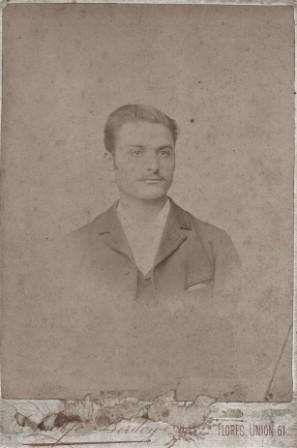
An article from 1890, published in the English-language newspaper "The Standart" – one of the many that were published in Argentina in that period in various languages – he spoke of the skill of the photographer Berdoy, advising him to the large English community that had settled in the neighborhood, which was very similar to the English countryside. Adolfo Berdoy was therefore a well-known photographer. Keep in mind then that taking a picture was not usual for anyone since it was very expensive and therefore the people who were photographed had to have a good economic position. We used to be photographed for example to send a photo to relatives abroad or to the future girlfriend when we didn't know each other, and there was also the habit of photographing the dead to remember their passage to the afterlife.
The Flores neighborhood was initially a vast rural neighborhood. In 1873 a "yellow fever" epidemic led to the death of a hundred people and for this reason many people left the city center and moved north of the city. To the west of the city was the Flores area, a nice and quiet area, where wealthy families started building their summer homes. Luxurious houses were built both in front of the train station that was located there, both along the Calle Rivadavia, the main street in the neighborhood, in which many immigrants from different countries lived (Italians above all, but also Spaniards, English, French, German, etc.), despite being in 12 kilometers from the city center, since both the train and the first trams arrived there. My great grandfather Antonio had his business right on Calle Rivadavia, a hundred meters from the church: a perfect location.

Here I end the first part of Antonio's life. Soon I will continue to tell you about “Buccino nella Storia” the story of my ancestors. See you on the next episode…
Note
- Municipality of Buccino, Birth certificates, year 1838, n. 163.
- Municipality of Buccino, Birth certificates, year 1838, n. 163.
- Parish of S. Croce, Baptismal Acts, f. 4r.
- Parish of S. Giovanni Gerosolimitano, Baptismal Acts.
- Municipality of Buccino, Marriage Records, year 1828, f. 35.
- Municipality of Buccino, Birth certificates, n. 135.
- Municipality of Buccino, Marriage Records, year 1866, n. 3. On the same day Rosa, Pietro's sister, he married Carmine Salvatore, brother of Maria Carmela (therein, n. 4). A note placed in the margin of Pietro's birth certificate strangely documents the marriage with reference to a report from the mayor on 26 February 1866. Perhaps an error must be assumed in the dating of the register act, perhaps out of confusion with the second family marriage.
- Giuseppe was born on 1 January 1868 and died on 1 November of the same year (Municipality of Buccino, Birth certificates, n. 5; Death records, n. 234).
- Municipality of Buccino, Birth certificates, n. 223.
- Municipality of Buccino, Birth certificates, n. 99.
- Municipality of Buccino, Death Proceedings, year 1880, n. 154.
- The father Michele Landolfi had already died at the time of the birth of his granddaughter Maria, while the mother Maria Carolina Speranza died in the house in via Piano il 5 December 1883 (Municipality of Buccino, Death Proceedings, n. 139).
- Argentina, National Census, 1895, Buenos Aires, section 23, subdivision D01-C16, sheet 7, riga 2 <https://bit.ly/3a91eSz>.

